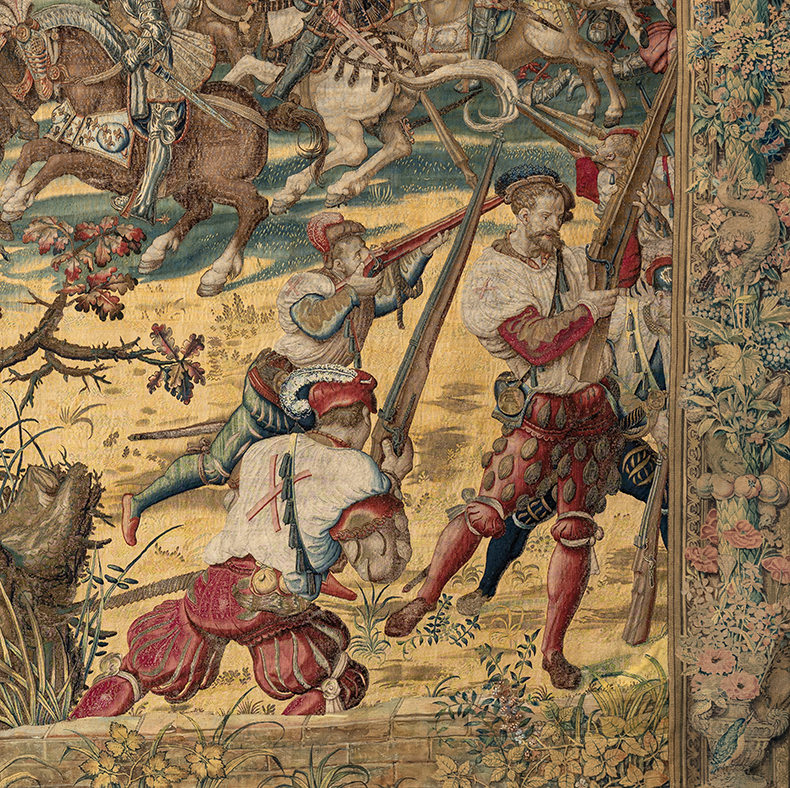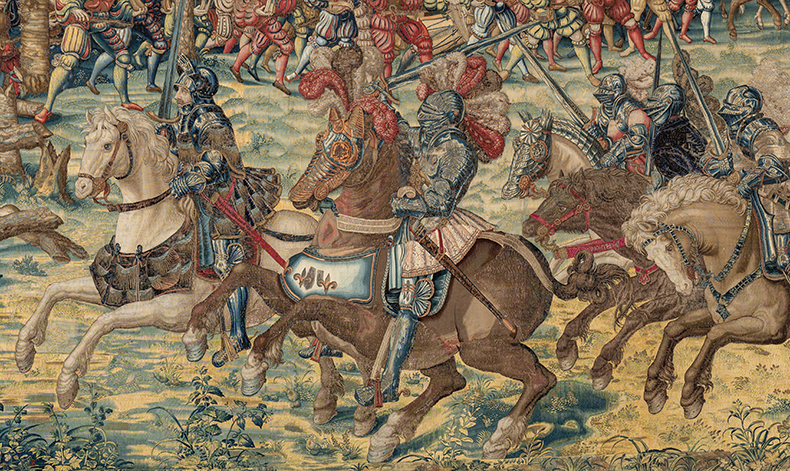From the June 2024 issue of Apollo. Preview and subscribe here.
The Advance of the Imperial Army and Counterattack of the French Cavalry Led by King Francis I (c. 1528–31) is a vast and complex tapestry, packed with detail. It’s one of a suite of seven tapestries designed by the Flemish artist Bernard van Orley that depict the Battle of Pavia, which took place near Milan around dawn on 24 February 1525. The battle was a turning point in the Italian War of 1521–26 between France and the Habsburg Empire, which then ruled much of Europe. The capture of Francis I, and the victory of the Holy Roman Emperor, Charles V, was a decisive moment. The French threat to control the Duchy of Milan and the Kingdom of Naples was thwarted, and the Empire maintained supremacy over the Mediterranean and beyond.
The Battle of Pavia tapestries were commissioned by the States General of the Low Countries, woven in the workshop of Willem and Jan Dermoyen (also known as Van der Moyen) in Brussels, and given to Charles V as a gift six years after the battle.
Each tapestry is spectacular. The Advance of the Imperial Army measures a monumental 4.15 x 8.78m – similar in scale to the rest of the series. When you see all of them together, you’re immersed in the action; the effect is almost cinematic.
The series is not strictly chronological: in this tapestry, the French king is shown twice, at two moments of the battle. In the central foreground he appears magnificently attired, charging ahead on a brown horse with the fleurs-de-lys on its breastplate, accompanied by four knights. He’s also shown in an earlier moment in the the righthand mid-ground, wearing that heavy armour and halo of plumage.
Van Orley’s design combines a brilliantly composed narrative with dramatic storytelling, but what really makes these tapestries so fantastic is the amount of detail. Everything competes for your eye. The quantity of vegetation – the ivy, berries, flowers – is like that seen in medieval designs, which often have a patterning of botanical motifs. But these are far more accurate and appear quite three dimensional. This is a real achievement in weaving.

The Advance of the Imperial Army and Counterattack of the French Cavalry Led by King Francis I (c. 1528–31), Willem and Jan Dermoyen, after Bernard van Orley. Museo e Real Bosco di Capodimonte, Naples
At the same time, The Advance of the Imperial Army gives us plenty of insights into the way that international military forces, formed of both professionals and mercenaries, fought at this time. As its title suggests, this tapestry shows the advance of the imperial army and the counterattack from the French cavalry.
The battle took place in Pavia, a town in Lombardy, in what was then contested territory. The town had been besieged by the French for about four months. There were a series of skirmishes and forays before the imperial forces breached the walled parkland surrounding Mirabello Castle in which the French had made their encampment.
What we’re seeing here is a stealth attack at dawn, in a field that was filled with watercourses, had undulating terrain and was half-obscured by a morning fog. Van Orley makes clear what was in reality quite chaotic – he has staged it for drama and clarity.
At the head of the columns of infantry were the more trained and experienced soldiers – known as Doppelsöldner, ‘double-pay soldiers’ – wielding double-handed swords or halberds (a spear topped with a battleaxe). The Doppelsöldner were part of the landsknechte: German mercenaries who were a crucial part of the imperial army. Next are the pikemen: the great mass of rank-and-file soldiers who didn’t wear armour. We can just see their raised pikes in the background. The infantry’s double-handed swords were used to hack into the pikemen’s formations – these were formidable weapons. Life for these soldiers was often brutal and short.
What’s most important here, militarily speaking, are the arquebuses. This was a new type of firearm with a long barrel, a forerunner to the musket. This was one of the first times that firearms had been decisive in battle. Arquebuses were key because they could shoot into the formerly invincible French heavy cavalry – so many knights were killed or taken prisoner. The artist mostly spares us these horrors.

Spanish imperial arquebusiers, in a detail from The Advance of the Imperial Army and Counterattack of the French Cavalry Led by King Francis I (c. 1528–31), Willem and Jan Dermoyen, after Bernard van Orley. Museo e Real Bosco di Capodimonte, Naples
At this time, warfare was a princely pursuit. We can see Francis I both leading the forces and raising his sword, moments from killing an opponent. (Charles V did not participate in the battle himself, as he was in Spain.) The French king’s horse is armoured, too, with plate armour decorated with fleurs-de-lys on its chest and an ornate chanfron (facial armour) magnificently crested with ostrich feathers. This all made the king – and his horse – highly visible, and therefore more vulnerable. (In a later tapestry, the captured king is depicted being helped off of his dying horse.)
The clothing of the soldiers, especially the landsknechte, is eye-catching: they are wearing fine doublets and breeches decorated with slashes, puffs and padding. Military uniforms didn’t exist at the time. Soldiers would spend their money on lavish costumes, which would have been quite expensive even second-hand. This extravagant dress was meant to impress and intimidate. The codpiece developed during this time – you can see it being worn here.
We don’t know exactly what sources Van Orley used to piece together his designs. ‘Father of the landsknechte’ Georg von Frundsberg, among others, wrote accounts of the battle, and there were prints of the locations and key figures that Van Orley would certainly have been familiar with. The artist’s preliminary compositions are today held in the Cabinet des Dessins at the Musée du Louvre. These ink and wash designs are quite close to the final works, though smaller – the largest is less than 80cm wide.
After finalising the compositions, Van Orley would have made watercolour cartoons to scale, for use by the weavers. These cartoons were cut into strips and then placed below the warps of the very large looms, so they could be copied. The weft threads would replicate nuances of colour to translate painting into tapestry. The way the craftspeople can take us into this space is incredible. There’s great skill in being able to produce aerial perspective – the way that tones become less saturated as you move into the background – and in creating that splendour of gold and silver threads.

Lavishly dressed imperial footsoldiers carrying arquebuses, in a detail from The Advance of the Imperial Army and Counterattack of the French Cavalry Led by King Francis I (c. 1528–31), Willem and Jan Dermoyen, after Bernard van Orley. Museo e Real Bosco di Capodimonte, Naples
In general, most cartoons were destroyed or discarded – perhaps they weren’t thought worth keeping. The most famous cartoons to survive are Raphael’s, for his Sistine Chapel tapestries (now on view in the Victoria and Albert Museum); these were woven in Brussels and Van Orley would have had some knowledge of them. I believe there’s a relationship between Raphael’s designs and Van Orley’s, particularly in the compositions and the action of the figures.
There are also strong similarities between the Battle of Pavia tapestries and the Hunts of Maximilian (1530s) series in the Louvre (also known as the Hunts of Charles V). They have very similar borders woven with garlands, fruits, vegetation, aquatic motifs, animals and so on. The Hunts are from the same period as the Battle of Pavia tapestries and were almost certainly designed by Van Orley, too. Parts of the horizontal borders on The Advance of the Imperial Army have been lost and replaced with recreations of the original design. These borders are important for its pictorial unity, for framing how you process the whole mass of action.
Such tapestries were far more prized and expensive than paintings during this period. Apart from the cost of materials – all that gold and silver, as well as wool and silk yarns in a vast range of colours – they were extremely costly in terms of manpower. Each would have taken at least 18 months to weave. All seven tapestries are now held by the Museo di Capodimonte in Naples, and have recently been restored. Nearly 500 years after the battle took place, this is the first opportunity to see the Battle of Pavia tapestries in the United States. Close looking will be rewarded, particularly when seeing the works in person. They are a superlative example of their type.

King Francis I and his knights, in a detail from The Advance of the Imperial Army and Counterattack of the French Cavalry Led by King Francis I (c. 1528–31), Willem and Jan Dermoyen, after Bernard van Orley. Museo e Real Bosco di Capodimonte, Naples
As told to Isabella Smith.
Nancy E. Edwards is curator of European art at the Kimbell Art Museum in Fort Worth, Texas.
‘Art and War in The Renaissance: The Battle of Pavia Tapestries’ is at the Kimbell Art Museum in Fort Worth, Texas, from 16 June until 15 September.
From the June 2024 issue of Apollo. Preview and subscribe here.














![Masterpiece [Re]discovery 2022. Photo: Ben Fisher Photography, courtesy of Masterpiece London](http://zephr.apollo-magazine.com/wp-content/uploads/2022/07/MPL2022_4263.jpg)
‘Like landscape, his objects seem to breathe’: Gordon Baldwin (1932–2025)